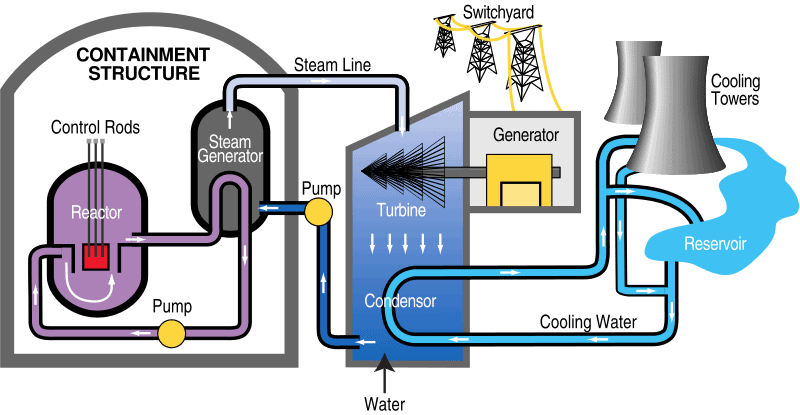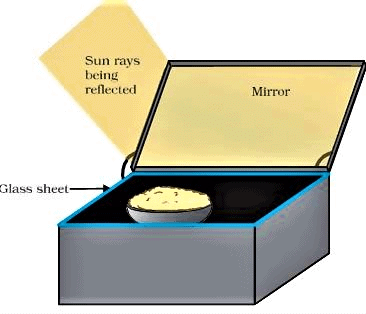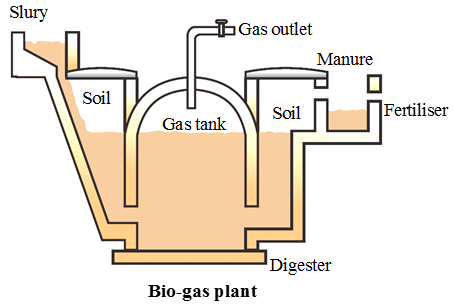NCERT Exemplar: Sources of Energy | Olympiad Preparation for Class 10 PDF Download
Multiple Choice Questions
Q.1. Which of the following is a non-renewable source of energy?
(a) Wood
(b) Sun
(c) Fossil fuels
(d) Wind
Ans: (c)
Q.2. Acid rain happens because
(a) sun leads to heating of upper layer of atmosphere
(b) burning of fossil fuels release oxides of carbon, nitrogen and sulphur in the atmosphere
(c) electrical charges are produced due to friction amongst clouds
(d) earth atmosphere contains acids
Ans: (b)
Q.3. Fuel used in thermal power plants is
(a) water
(b) uranium
(c) biomass
(d) fossil fuels
Ans: (d)
Q.4. In a hydro power plant
(a) Potential energy possessed by stored water is converted into electricity
(b) Kinetic energy possessed by stored water is converted into potential energy
(c) Electricity is extracted from water
(d) Water is converted into steam to produce electricity
Ans: (a)
Q.5. Which is the ultimate source of energy?
(a) Water
(b) Sun
(c) Uranium
(d) Fossil fuels
Ans: (b)
Q.6. Which one of the following forms of energy leads to least environmental pollution in the process of its harnessing and utilisation?
(a) Nuclear energy
(b) Thermal energy
(c) Solar energy
(d) Geothermal energy
Ans: (c)
Q.7. Ocean thermal energy is due to
(a) energy stored by waves in the ocean
(b) temperature difference at different levels in the ocean
(c) pressure difference at different levels in the ocean
(d) tides arising out in the ocean
Ans: (b)
Q.8. The major problem in harnessing nuclear energy is how to
(a) split nuclei?
(b) sustain the reaction?
(c) dispose off spent fuel safely?
(d) convert nuclear energy into electrical energy?
Ans: (c)
Q.9. Which part of the solar cooker is responsible for green house effect?
(a) Coating with black colour inside the box
(b) Mirror
(c) Glass sheet
(d) Outer cover of the solar cooker
Ans: (c)
Q.10. The main constituent of biogas is
(a) methane
(b) carbon dioxide
(c) hydrogen
(d) hydrogen sulphide
Ans: (a)
Q.11. The power generated in a windmill
(a) is more in rainy season since damp air would mean more air mass hitting the blades
(b) depends on the height of the tower
(c) depends on wind velocity
(d) can be increased by planting tall trees close to the tower
Ans: (c)
Q.12. Choose the correct statement
(a) Sun can be taken as an inexhaustible source of energy
(b) There is infinite storage of fossil fuel inside the earth
(c) Hydro and wind energy plants are non polluting sources of energy
(d) Waste from a nuclear power plant can be easily disposed off
Ans: (a)
Q.13. In a hydroelectric power plant more electrical power can be generated if water falls from a greater height because
(a) its temperature increases
(b) larger amount of potential energy is converted into kinetic energy
(c) the electricity content of water increases with height
(d) more water molecules dissociate into ions
Ans: (b)
14. Choose the incorrect statement regarding wind power
(a) It is expected to harness wind power to minimum in open space
(b) The potential energy content of wind blowing at high altitudes is the source of wind power
(c) Wind hitting at the blades of a windmill causes them to rotate. The rotation thus achieved can be utilised further
(d) One possible method of utilising the energy of rotational motion of the blades of a windmill is to run the turbine of an electric generator
Ans: (b)
15. Choose the incorrect statement
(a) We are encouraged to plant more trees so as to ensure clean environment and also provide bio-mass fuel
(b) Gobar-gas is produced when crops, vegetable wastes etc., decompose in the absence of oxygen
(c) The main ingredient of bio-gas is ethane and it gives a lot of smoke and also produces a lot of residual ash
(d) Bio-mass is a renewable source of energy
Ans: (c)
Short Answer Type Questions
Q.16. Why is there a need to harness non-conventional sources of energy? Give two main reasons.
Ans: Two main reasons to harness the non-conventional sources of energy are:
- Our demand for energy is increasing to improve the standard of life and growing to meet the needs of the population.
- Uses of conventional source of energy (coal, petroleum etc) which are limited, exhaustible and causes a lot of pollution.
To reduce pollution, the use of a non-conventional source of energy is necessary for us.
Q.17. Write two different ways of harnessing energy from ocean.
Ans: Ocean thermal energy and tidal energy can be harnessed from the ocean.
 Ocean Thermal Energy
Ocean Thermal Energy
Q.18. What steps would you suggest to minimise environmental pollution caused by the burning of fossil fuels?
Ans: Steps to minimise environmental pollution caused by burning of fossil fuels are as follows.
- Use non-conventional sources of energy such as hydrothermal and wind energy.
- Afforestation should be adopted to control air pollution
- Smokeless appliances should be used to reduce the pollution
Q.19. What is the role of a plane mirror and a glass sheet in a solar cooker?
Ans: Plane mirror reflects the sunlight thereby increasing the intensity of solar energy. Glass sheet prevents heat escape from solar cooker.
Q.20. Mention three advantages of a solar cell?
Ans: Advantages of a solar cell is as follows.
- Solar cells are the source of renewable energy
- Solar cells do not produce pollution
- Solar cells need minimum maintenance
Q.21. What is biomass? What can be done to obtain bio-energy using biomass?
Ans: Fuel obtained from organic material is called biomass. Following are the methods to obtain bio-energy using biomass.
- Using firewood as a fuel
- Preparing cow dung cake and use them as heating source
- Gobar gas can be produced
- Electricity can be produced by using gobar.
Q.22. What are the limitations in obtaining energy from wind?
Ans: Limitations in obtaining energy from wind.
- There will not be continuous and consistent production
- Area required to install wind power mill is large.
- Minimum speed of the wind should be 15 km/hour.
Long Answer Type Questions
Q.23. Which is the process used to harness nuclear energy these days? Explain it briefly.
Ans: Nuclear energy is harnessed in nuclear power plants. It has a nuclear reactor, boiler and turbine.
- The nuclear reactor is the place where nuclear fission is carded out. Nuclear fission produces a huge amount of energy.
- Energy produced during nuclear fission is utilized to boil water, so that steam can be generated.
- Steam is utilized to turn the turbines to produce electricity.

Q.24. How can solar energy be harnessed? Mention any two limitations in using solar energy. How are these limitations overcome?
Ans: Solar Cookers and solar water heaters:
A black surface absorbs more heat as compared to a white or a reflecting surface under identical conditions. Solar cookers (Fig. 14.6) and solar water heaters use this property in their working. Some solar cookers achieve a higher temperature by using mirrors to focus the rays of the Sun. Solar cookers are covered with a glass plate. Solar energy trapped is reflected by the glass sheet which makes the food cook.

Solar Cell:
A typical cell develops a voltage of 0.5–1 V and can produce about 0.7 W of electricity when exposed to the Sun. A large number of solar cells are, combined in an arrangement called solar cell panel (Fig. 14.7) that can deliver enough electricity for practical use. The principal advantages associated with solar cells are that they have no moving parts, require little maintenance and work quite satisfactorily without the use of any focussing device. Another advantage is that they can be set up in remote and inaccessible hamlets or very sparsely inhabited areas in which laying of a power transmission line may be expensive and not commercially viable.

Q.25. Make a list of conventional and non-conventional sources of energy. Give a brief description of harnessing one nonconventional source of energy.
Ans: Conventional sources of energy are coal, petroleum, firewood and tidal energy.
Non-conventional sources are Solar energy, nuclear energy, Biogas, Tidal energy, Ocean thermal energy, wave energy etc.
Methods to harness Non-conventional sources of energy.
- Solar Energy can be harnessed by using solar cookers, solar water heaters, solar cells and solar panels.
- Nuclear power can be converted to electric energy with the help of nuclear reactors.
- The water at the surface of the sea or ocean is heated by the Sun while the water in deeper sections is relatively cold. This difference in temperature is exploited to obtain energy in ocean-thermal-energy conversion plants.
- The kinetic energy possessed by huge waves near the seashore can be trapped in a similar manner to generate electricity. The waves are generated by strong winds blowing across the sea. Wave energy would be a viable proposition only where waves are very strong.
Q.26. Why is there a need for harnessing non-conventional sources of energy? How can energy be harnessed from the sea in different ways?
Ans: Following are the reason for the need to harness non-conventional sources of energy.
- Conventional sources are an exhaustible source of energy and they will get exhausted in the near future.
- Non-conventional source of energy did not lead to environmental pollution.
Energy can be harnessed from the sea in the following ways:
- Tidal energy: Tidal energy is harnessed by constructing a dam across a narrow opening to the sea. A turbine fixed at the opening of the dam converts tidal energy to electricity. As you can guess, the locations where such dams can be built are limited.
- Wave energy: The kinetic energy possessed by huge waves near the seashore can be trapped in a similar manner to generate electricity. The waves are generated by strong winds blowing across the sea. Wave energy would be a viable proposition only where waves are very strong.
- Ocean Thermal Energy: The water at the surface of the sea or ocean is heated by the Sun while the water in deeper sections is relatively cold. This difference in temperature is exploited to obtain energy in ocean-thermal-energy conversion plants.
Q.27. What are the environmental consequences of using fossil fuels? Suggest the steps to minimise the pollution caused by various sources of energy including non-conventional sources of energy.
Ans: Environmental consequences of using fossil fuels are:
- They are the largest emitters of greenhouse gases such as carbon dioxide and methane.
- Extraction of conventional fuels threatens the ecological balance in many areas.
- These fuels cause environmental problems due to pollution.
Steps to minimize pollution are:
- The dependency on fossil fuels should be reduced by switching to alternate sources of energy.
- The judicious use of energy by avoiding wastage can reduce environmental problems.
- Regular servicing of energy conversion devices should be done in order to maintain their efficiency.
- We should focus on developing technology that could make energy conversion devices much more efficient and cleaner.
- Research should be continued to produce long-lasting devices so that the environmental damage caused by the assembly of devices gets minimized.
Q.28. Energy from various sources is considered to have been derived from the sun. Do you agree? Justify your answer.
Ans: Yes, the sun is the ultimate source of energy. Directly or indirectly, all the forms of energy are derived from solar energy.
Non-renewable sources of energy: Fossil fuels like coal, petroleum and natural gas are formed due to the burial of large plants and ancient creatures whose ultimate source of energy is the sun.
Renewable sources of energy: They are indirectly derived from solar energy such as
- Energy from flowing water: Clouds are formed when water in lakes, rivers, seas etc. evaporates due to solar energy. They bring rainfall and snowfall. The rain and melting snow feed rivers, streams etc. This flowing water can be used for getting hydroelectricity.
- Wind energy: Wind energy arises due to uneven heating of the earth’s surface by the sun rays at two different adjoining places. Due to this, wind possesses kinetic energy.
- Bio-energy: Plants in the process of photosynthesis converts solar energy into glucose i.e. food (chemical energy). This food is consumed by animals. Thus, the animal wastes and remains of the plants constitute biomass that can be utilised as a source of energy.
- Wave energy: The waves are generated by strong winds (due to solar energy) blowing across the sea.
- Ocean thermal energy: Sun is responsible for the temperature difference between the water at the surface and water at depth in seas and oceans.
Thus, the energy from various sources is considered to have been derived from the sun.
Q.29. What is biomass? Explain the principle and working of a biogas plant using a labelled schematic diagram.
Ans: Sources of fuel obtained from organic material are called biomass.
Cow-dung, various plant materials like the residue after harvesting the crops, vegetable waste and sewage are decomposed in the absence of oxygen to give bio-gas.
The plant has a dome-like structure built with bricks. A slurry of cow-dung and water is made in the mixing tank from where it is fed into the digester. The digester is a sealed chamber in which there is no oxygen. Anaerobic micro-organisms that do not require oxygen decompose or break down complex compounds of the cow-dung slurry. It takes a few days for the decomposition process to be complete and generate gases like methane, carbon dioxide, hydrogen and hydrogen sulphide. The bio-gas is stored in the gas tank above the digester from which they are drawn through pipes for use.

Biogas is an excellent fuel as it contains up to 75% methane. It burns without smoke, leaves no residue like ash in wood, charcoal and coal burning. Its heating capacity is high. Biogas is also used for lighting. The slurry left behind is removed periodically and used as excellent manure, rich in nitrogen and phosphorous. The large-scale utilisation of bio-waste and sewage material provides a safe and efficient method of waste disposal besides supplying energy and manure.
|
70 videos|242 docs|187 tests
|
FAQs on NCERT Exemplar: Sources of Energy - Olympiad Preparation for Class 10
| 1. What are the different types of energy sources? |  |
| 2. What is the significance of renewable energy sources? |  |
| 3. How does solar energy work? |  |
| 4. What are the advantages of using wind energy? |  |
| 5. What are the environmental impacts of using fossil fuels? |  |





















